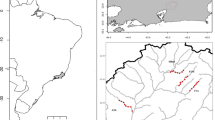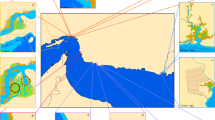Abstract
The functional habitat concept was applied to a large Italian river for the first time. The characteristically wide range of hydraulic conditions present in this river (compared to previously-studied small, lowland, English rivers) were expected to be of central importance to biota and, therefore, to habitat definition. TWINSPAN analysis of the invertebrate assemblages sampled in the Ticino river identified five distinct habitats: two habitats in lotic areas (run-riffle and macrophytes in current), two along the river margins (with and without macrophytes) and one in backwater areas. These correspond to five of the functional habitats identified in U.K. lowland rivers. Each of these five functional habitats could be defined either in terms of hydraulics, substratum and/or presence/absence of macrophytes. Representative taxa are presented for each habitat and community structure discussed. Macrophyte and run-riffle habitats supported the most heterogeneous and abundant benthic fauna. No match was found between replicates grouped by invertebrate assemblage (the five functional habitats identified by TWINSPAN) and the grouping of the same replicates by PCA, carried out on the physical data matrix. While obvious velocity differences were found between the functional habitats, of particular note was the fact that the Froude number did not show any clear association with habitat type. In the future, improved river management will follow improved understanding of river habitats.
Similar content being viewed by others

References
Anderson, R. V. & D. M. Day, 1986. Predictive quality of macroinvertebrate-habitat associations in lower navigation pools of the Mississippi River. Hydrobiologia 136 (Dev. Hydrobiol. 31): 101–112.
Armitage, P. D. & I. Pardo, 1995. Impact assessment of regulation at the reach level using macroinvertebrate information from mesohabitats. Regul. Riv. Res. Managem. 10: 147–158.
Bhowmilk, N. G. & M. Demissie, 1982. Bed material sorting in pools and riffles. Proceedings of the American Society of Civil Engineers. Journal of the Hydraulics Division 108(HY10): 1227–1231.
Bovee, K. D., 1982. A guide to stream habitat analysis using the Instream Flow Incremental Methodology. U.S. Fish and Wildlife Service Biological Series Program FWS / OBS-82/26. U.S. Department of the Interior, Fish and Wildlife Service, Washington, D.C.
Buffagni, A. (in press). The use of benthic invertebrate production for the definition of Ecologically Acceptable Flows in high gradient rivers. In Acreman, M. C. (ed.), IAHS Red Book on Hydro-ecology, Wallingford.
Buffagni, A. & E. Comin, 2000. Secondary production of benthic communities at the habitat scale as a tool to assess ecological integrity in mountain streams. Hydrobiologia 422/423 (Dev. Hydrobiol. 149): 183–195.
Chow, V. T., 1959. Open Channel Hydraulic. McGraw-Hill, Kogakusha, Japan. 680 pp.
Cogerino, L., B. Cellot & M. Bournaud, 1995. Microhabitat diversity and associated macroinvertebrates in aquatic banks of a large European river. Hydrobiologia 304: 103–115.
Cotta-Ramusino, M., G. Crosa & A. Buffagni, 1991. Microhabitat preferences of benthic fauna (Ephemeroptera) in plane-springs (Fontanili). Verh. int. Ver. Limnol. 24: 1626–1628.
Crosa, G., A. Buffagni & M. Cotta-Ramusino, 1991. Granulometria e profilo del substrato come fattori ecologici nella distribuzione del macrobentos. Atti della Società Italiana di Ecologia 12: 595–598.
Ghetti, P. F., 1986. I macroinvertebrati nell'analisi di qualità dei corsi d'acqua. Provincia autonoma di Trento: 105 pp.
Gore, J. A., 1978. A technique for predicting in-stream flow requirements of benthic macroinvertebrates. Freshwat. Biol. 8: 141–151.
Gregg, W. W. & F. L. Rose, 1985. Influences of aquatic macrophytes on invertebrate community structure, guild structure, and microdistribution in streams. Hydrobiologia 128: 45–56.
Hamilton, K. & E. P. Bergensen, 1985. Methods to Estimate Aquatic Habitat Variables. Colorado Cooperative Fishery Research Unit; 201 Wagar, Colorado State University Fort Collins, CO. Report, Project number DPTS-35-9.
Harper, D. M., C. D. Smith & P. J. Barham, 1992. Habitat as the building blocks for river conservation assessment. In Boon, P. J., P. Calow & G. E. Petts (eds), River Conservation and Management. John Wiley & Sons Ltd, Chichester: 311–319.
Harper, D. M., C. D. Smith, P. J. Barham & R. Howell, 1995. The ecological basis for the management of the natural river environment. In Harper, D. M. & A. J. D. Ferguson (eds), The Ecological Basis for River Management. JohnWiley & Sons Ltd, Chichester: 219–238.
Harper, D. M., M. Ebrahimnezhad & F. Climent, 1998a. Artificial riffles in river rehabilitation: setting the goals and measuring the successes. Aquatic Conserv: Mar. Freshw. Ecosyst. 8: 5–16.
Harper, D. M., C. D. Smith, J. L. Kemp & G. A. Crosa, 1998b. The use of 'functional habitats' in the conservation, management and rehabilitation of rivers. In Bretschko, G. & J. Halesic (eds), Advances in River Bottom Ecology. Backhuys Publishers, Leiden, The Netherlands: 315–326.
Hildrew, A. G. & P. S. Giller, 1994. Patchiness, species interactions and disturbance in stream communities. In Giller, P. S., A. G. Hildrew & D. G. Rafaelli (eds), Aquatic Ecology: Scale, Pattern and Process. Blackwell Scientific Publications, Oxford: 21–62.
Hill, M. O., R. G. H. Bunce & M. W. Shaw, 1975. Indicator species analysis, a divisive polythetic method of classification, and its application to a survey of native pinewoods in Scotland. J. Ecol. 63: 597–613.
Hill, M. O., 1979. TWINSPAN-A FORTRAN program for arranging multivariate data in an ordered two-way table by classification of the individuals and attributes. Ecology and Systematics, Cornell University, Ithaca, New York.
Jenkins, R. A., K. R. Wade & E. Pugh, 1984. Macroinvertebratehabitat relationships in the River Teifi catchment and the significance to conservation. Freshwat. Biol. 14: 23–42.
Jowett, I. G., J. Richardson, B. J. F. Biggs, C. W. Hickey & J. M. Quinn, 1991. Microhabitat preferences of benthic invertebrates and the development of generalised Deleatidium spp. habitat suitability curves, applied to four New Zealand rivers. New Zealand J. mar. Freshwat. Res. 25: 187–199.
Jowett, I. G., 1993. A method for objectively identifying pool, run, and riffle habitats from physical measurements. New Zealand J. mar. Freshwat. Res. 27: 241–248.
Kemp, J. L. & D. M. Harper, 1997. River Deben Alleviation of Low flows Scheme: proposals for channel habitat physical rehabilitation in association with flow augmentation. Anglian Region, Environment Agency of England and Wales.
Kemp, J. L., D. M. Harper & G. A. Crosa, 1999. Use of 'functional habitats' to link ecology with morphology and hydrology in river rehabilitation. Aquatic Conserv: Mar. Freshwat. Ecosyst. 9: 159–178.
Kemp, J. L., D. M. Harper & G. A. Crosa, in press. The habitat-scale ecohydraulics of rivers. Ecological Engineering.
Krebs, C. J., 1989. Ecological Methodology. Harper Collins, New York.
Metcalfe, J. L., 1989. Biological water quality assessment of running waters based on macroinvertebrate communities: History and present status in Europe. Environmental Pollution 60: 101–139.
Metcalfe-Smith, J. L., 1994. Biological water quality assessment of rivers: use of macroinvertebrate communities. In Calow, P. & G. E. Petts (eds), The Rivers Handbook, Vol. II. Blackwell Scientific Publishers, London: 144–170.
Milner, N. J., R. J. Hemsworth & B. E. Yones, 1985. Habitat evaluation as a fisheries management tool. J. Fish Biol. 27 (Supplement A): 85–108.
Milhous, R. T., M. A. Updike & D. M. Schneider, 1989. Physical Habitat Simulation System Reference Manual-Version II. U.S. Fish Wildl. Serv., Biol. Rep. 89(16). v.p.
Milhous, R. T., J. M. Bartholow, M. A. Updike & A. R. Moos, 1990. Reference manual for generation and analysis of habitat time series-Version II. U.S. FishWildl. Serv., Biol. Rep. 90(16): 249 pp.
Moon, H. P., 1939. Aspects of the ecology of aquatic insect. Transactions of the British Entomological Society 6: 39–49.
Moore, K. M. S., K. K. Jones & J. M. Dambacher, 1997. Methods for stream habitat surveys. Oregon Department of Fish and Wildlife, Information Reports 97-4: 1–40.
National Rivers Authority, 1993. River Corridor Manual for Surveyors. National Rivers Authority, Rivers House, Aztec Park, Bristol.
Orth, D. J. & O. E. Maughan, 1983. Microhabitat preferences of benthic fauna in a woodland stream. Hydrobiologia 106: 157–168.
Padmore, C. L., M. D. Newson & M. E. Charlton, 1998. Instream habitat in gravel bed rivers: identification and characterisation of biotopes. In Klingeman, P. C., R. L. Beschta, P. D. Komar & J. B. Bradley (eds), Gravel Bed Rivers in the Environment (International Workshop). Englewood, Colorado, Water Resources Publications: 345–364.
Poole, G. C., C. A. Frissell & S. C. Ralph, 1997. In-stream habitat unit classification-inadequacies for monitoring and some consequences for management. J. am. Wat. Res Ass. 33: 879–896.
Pardo, I. & Armitage, P. D., 1997. Species assemblages as descriptors of mesohabitats. Hydrobiologia 344: 111–128.
Parsons, M. & R. H. Norris, 1996. The effect of habitat specific sampling on biological assessment of water quality using a predictive model. Freshwat. Biol. 36: 419–434.
Singh, K. P. & S. M. Broeren, 1989. Hydraulic geometry of streams and stream habitat assessment. J.Wat. Res. Plan. Managem. 115: 583–597.
Smith, C. D., D. M. Harper & P. J. Barham, 1991. Physical environment for river invertebrate communities, Project Report, National River Authority (Anglian Region), Operational Investigation A13-38A.
Smock, L. A., E. Gilinsky & D. L. Stoneburner, 1985. Macroinvertebrate production in a southeastern United States stream. Ecology 66: 1491–1503.
Sokal, R. R. & F. J. Rohlf, 1981. Biometry. W. H. Freeman and Company, New York.
Ter Braak, C. J. F., 1991. CANOCO. Agricultural Mathematics Group, DLO, Wageningen, The Netherlands.
Verneaux, J., P. Galmiche, F. Janier & A. Monnot, 1982. Une nouvelle methode pratique d'evaluation de la qualité des eaux courantes: un indice biologique de qualité générale (I.B.G.). Annales Scientifiques de l'Université de Franche-Comté Besançon, Biologie animale 3: 11–21.
Wadeson, R. A., 1994. A geomorphological approach to the identification and classification of instream flow environment. South African J. aquat. Sci. 20: 38–61.
Woodiwiss, F. S. & S. Rees, 1978. Biological water assessment methods. Third Technical Seminar, Commission of the European Communities Environment, ENV/729/80, Vol. 1: 417–440.
Wolman, M. G., 1955. The Natural Channel of Brandywine Creek, Pennsylvania. U.S. Geological Survey Professional Paper 271, U.S.G.S. Washington, D.C.
Author information
Authors and Affiliations
Rights and permissions
About this article
Cite this article
Buffagni, A., Crosa, G.A., Harper, D.M. et al. Using macroinvertebrate species assemblages to identify river channel habitat units: an application of the functional habitats concept to a large, unpolluted Italian river (River Ticino, northern Italy). Hydrobiologia 435, 213–225 (2000). https://doi.org/10.1023/A:1004124717508
Issue Date:
DOI: https://doi.org/10.1023/A:1004124717508



